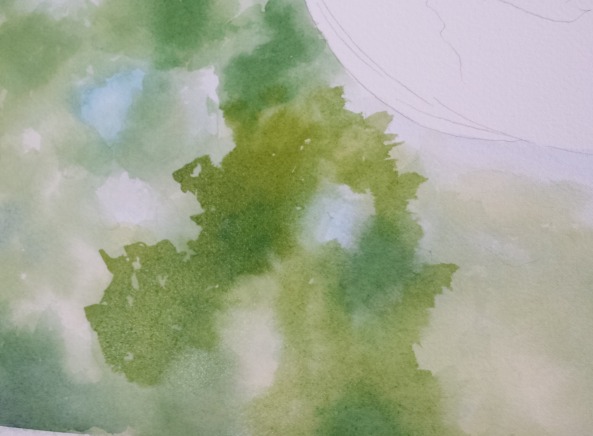One Kind of Out of Focus Background in Watercolor

(Click on the image to enlarge)
The color of the horse will be dark enough that I didn't mask it, since any bit of color I get accidentally on him will be covered up. The first step was to do a plain water wash in the sky bits, and then drop in some Ultramarine Blue and Cobalt Blue and a smidgen of Manganese Blue Hue down on the right. After that was dry, I wet the rest of the background and dropped in Gamboge. All this was done with a size 16 round. Also, I placed a piece of wood 2 by 4 under the top end of my board so that there was a slight tilt to it. That helped the water and pigment move downward, keeping a wet edge so my washes would be smooth.
As you can see in the photo, I also did a cooler light green wash on the bottom, which will be grass, and avoided the dandelions.
The color of the horse will be dark enough that I didn't mask it, since any bit of color I get accidentally on him will be covered up. The first step was to do a plain water wash in the sky bits, and then drop in some Ultramarine Blue and Cobalt Blue and a smidgen of Manganese Blue Hue down on the right. After that was dry, I wet the rest of the background and dropped in Gamboge. All this was done with a size 16 round. Also, I placed a piece of wood 2 by 4 under the top end of my board so that there was a slight tilt to it. That helped the water and pigment move downward, keeping a wet edge so my washes would be smooth.
As you can see in the photo, I also did a cooler light green wash on the bottom, which will be grass, and avoided the dandelions.

When all of that was quite dry, I wet the tree sections again and began to drop in greens, varying the shades and values slightly, using Sap Green, Gamboge, Aureolin, Quinacridone Rust, Phthalo Green and Transparent Orange, using a slightly smaller brush. Certainly, you can use whatever you like to make greens, those are just the ones I used. Down near the horizon and the right side, I also added some Dioxazine Purple and dulled it with a bit of one of my green mixes. The I let all of this dry thoroughly.
As the need to put darker areas in came up, I only wet small sections at a time and often just put color in wet into dry, then softened the edges with a thirsty brush. (A thirsty brush is one that has been cleaned, dampened and had most of the water removed) In some places, I dropped wet into dry, cleaned my brush, dabbed it on a towel, but left some water in it and scrumbled the edges, (laid my brush flat on the paper at the edge of the paint and wiggled it away from the wet paint into dry paper) then soaked up some spots with a paper towel. Just have fun creating deeper colors and contrasts.
When that was done to my satisfaction, I again, let it dry. This time I let it dry over night. I wanted the color to be firmly in the paper so that my next step wouldn't disturb it unduly. The next morning I used a soft Hake brush, loaded it with water and a very small amount of ultramarine blue and carefully laid the wash over all the painted area, starting at the top and working my way down the page. Then I left it for a day. That good soaking softened any hard edges that might be left and the slight blue blended all colors into a hazy distant look. In fact it was so fuzzy, I thought my camera was out of focus at first. Having the rest of the painting done will make it the proper background. I have most of it done, now and it does look a bit more "together".
I hope this little demonstration is a help to you in your painting journey. Happy painting. ----Susan----





